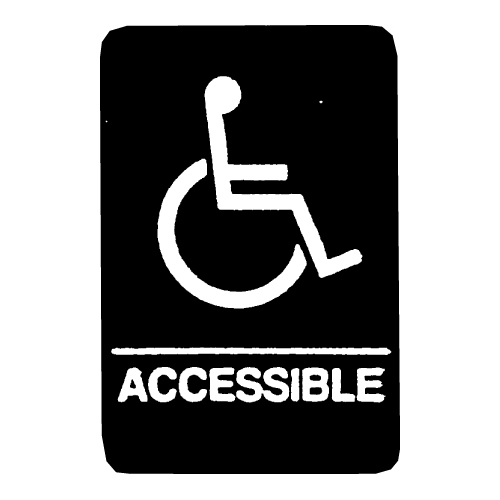Exploring the Secret Attributes of ADA Indications for Enhanced Access
In the realm of accessibility, ADA signs serve as silent yet powerful allies, guaranteeing that rooms are accessible and inclusive for people with handicaps. By integrating Braille and tactile components, these indications break barriers for the aesthetically impaired, while high-contrast color schemes and understandable fonts cater to diverse visual demands.
Importance of ADA Compliance
Guaranteeing conformity with the Americans with Disabilities Act (ADA) is critical for cultivating inclusivity and equivalent gain access to in public rooms and workplaces. The ADA, established in 1990, mandates that all public facilities, employers, and transportation solutions suit people with handicaps, ensuring they enjoy the very same civil liberties and possibilities as others. Compliance with ADA standards not only meets legal commitments however also boosts an organization's reputation by showing its dedication to diversity and inclusivity.
Among the essential aspects of ADA compliance is the implementation of available signage. ADA indications are designed to make sure that individuals with handicaps can easily navigate with buildings and rooms. These signs need to follow certain standards relating to size, typeface, color contrast, and placement to ensure presence and readability for all. Correctly carried out ADA signage helps get rid of barriers that people with impairments frequently experience, thus promoting their independence and confidence (ADA Signs).
Additionally, sticking to ADA policies can reduce the risk of lawful consequences and possible penalties. Organizations that fall short to abide with ADA standards might face fines or legal actions, which can be both damaging and financially challenging to their public picture. Hence, ADA conformity is indispensable to cultivating an equitable setting for everyone.
Braille and Tactile Components
The consolidation of Braille and responsive aspects into ADA signage symbolizes the concepts of accessibility and inclusivity. It is commonly placed beneath the equivalent text on signage to make sure that people can access the details without aesthetic help.
Tactile elements expand beyond Braille and include elevated personalities and icons. These components are developed to be discernible by touch, allowing people to determine area numbers, toilets, leaves, and various other important locations. The ADA sets certain guidelines relating to the size, spacing, and positioning of these responsive aspects to enhance readability and guarantee consistency throughout various settings.

High-Contrast Color Design
High-contrast shade plans play a pivotal function in improving the visibility and readability of ADA signs for individuals with aesthetic disabilities. These schemes are important as they optimize the distinction in light reflectance between message and background, making certain that indications are easily noticeable, even from a range. The Americans More Info with Disabilities Act (ADA) mandates making use of specific shade contrasts to suit those with restricted vision, making it an essential facet of compliance.
The efficiency of high-contrast shades lies in their capacity to stand apart in numerous lighting problems, consisting of dimly lit atmospheres and locations with glare. Commonly, dark message on a light history or light message on a dark background is utilized to attain optimal comparison. Black text on a yellow or white history provides a plain aesthetic distinction that assists in quick recognition and understanding.

Legible Fonts and Text Size
When taking into consideration the layout of ADA signs, the selection of readable fonts and suitable text size can not be overemphasized. The Americans with Disabilities Act (ADA) mandates that typefaces need to be sans-serif and not italic, oblique, script, very attractive, or of uncommon type.
The size of the message likewise plays an essential function in ease of access. According to ADA guidelines, the minimal message elevation need to be 5/8 inch, and it must enhance proportionally with seeing distance. This is specifically vital in public rooms where signage demands to be checked out rapidly and properly. Uniformity in message dimension adds to a natural aesthetic experience, aiding individuals in browsing atmospheres efficiently.
Moreover, spacing in between lines and letters is indispensable to legibility. Ample spacing stops characters from showing up crowded, enhancing readability. By adhering to these criteria, developers can read the article dramatically boost availability, ensuring that signage serves its desired function for all people, no matter of their visual capacities.
Efficient Placement Methods
Strategic placement of ADA signs is important for making the most of access and making sure compliance with lawful requirements. Effectively positioned indications direct people with disabilities efficiently, assisting in navigating in public spaces. Trick considerations include height, visibility, and closeness. ADA standards stipulate that indicators should be installed at an elevation in between 48 to 60 inches from the ground to guarantee they are within the line of view for both standing and seated people. This standard elevation range is crucial for inclusivity, making it possible for get redirected here wheelchair customers and people of differing elevations to access information effortlessly.
Furthermore, signs must be positioned nearby to the latch side of doors to allow very easy recognition before access. Consistency in indicator placement throughout a center improves predictability, reducing complication and improving general user experience.

Conclusion
ADA indications play an important function in promoting ease of access by integrating functions that deal with the needs of individuals with specials needs. These components jointly promote an inclusive atmosphere, emphasizing the importance of ADA conformity in ensuring equal gain access to for all.
In the world of availability, ADA indications serve as silent yet effective allies, making sure that rooms are inclusive and accessible for people with impairments. The ADA, passed in 1990, mandates that all public facilities, employers, and transport solutions fit individuals with handicaps, guaranteeing they take pleasure in the exact same rights and opportunities as others. ADA Signs. ADA indicators are created to ensure that individuals with handicaps can quickly navigate through rooms and structures. ADA guidelines specify that indications should be installed at a height between 48 to 60 inches from the ground to ensure they are within the line of view for both standing and seated individuals.ADA indicators play an important duty in promoting availability by incorporating features that resolve the requirements of people with impairments